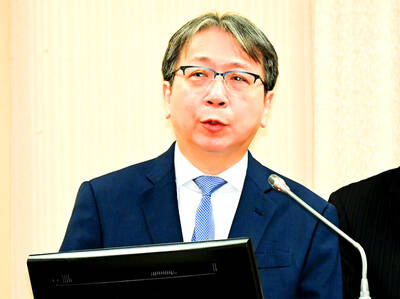A high-energy synchrotron radiation beamline jointly created by Taiwan and Japan was inaugurated in Hyogo Prefecture, Japan, yesterday, to facilitate cutting-edge life-science and materials research.
The facility marks the first time that Taiwan has managed to break China's diplomatic embargo to forge a joint venture with Japan in the high-technology field.
The new beamline, believed to be the world's strongest and most powerful synchrotron radiation light source, was co-produced by Taiwan's Synchrotron Radiation Research Center (SRRC) and the SPring-8 Light Source under the Japan Synchrotron Radiation Research Institute (JSRRI).
Taiwan's National Science Council Chairman Weng Cheng-i (
"This ceremony signifies a great step in Taiwan-Japanese scientific collaboration," Weng said.
Speaking on the occasion, Chen said the new beamline will allow Taiwan scientists to perform exclusive research into biological structure and state-of-the-art materials science from next year.
"I firmly believe that this exciting moment will serve as an important milestone in continuing the collaboration between Japan's and Taiwan's scientific communities for decades to come," Chen said.
Chen said the inauguration of the new facility is expected to lead Taiwan into brand new research frontiers in life science and cutting-edge materials development.
Taiwan installed a synchrotron radiation accelerator in October 1993. It can produce third-generation beamlines for soft X-ray-related scientific research. The accelerator, however, cannot provide beamlines for hard X-ray-related scientific experiments.
Taiwan then proposed at the 1996 ministerial-level meeting of the Asia-Pacific Economic Cooperation forum that all APEC member economies open their synchrotron radiation research facilities for joint research.
On this international project, Taiwan is devoted to completing two hard X-ray beamlines by offering both technical and financial assistance, amounting to about NT$350 million, within five years.
SRRC director Chen told the Taipei Times that several research teams in Taiwan had expressed their interest in using beamlines established at SPring-8, including Academia Sinica, the Industrial Technology Research Institute and Chung Shan Institute of Science and Technology under the Ministry of National Defense.

The US government has signed defense cooperation agreements with Japan and the Philippines to boost the deterrence capabilities of countries in the first island chain, a report by the National Security Bureau (NSB) showed. The main countries on the first island chain include the two nations and Taiwan. The bureau is to present the report at a meeting of the legislature’s Foreign Affairs and National Defense Committee tomorrow. The US military has deployed Typhon missile systems to Japan’s Yamaguchi Prefecture and Zambales province in the Philippines during their joint military exercises. It has also installed NMESIS anti-ship systems in Japan’s Okinawa

TRAGEDY STRIKES TAIPEI: The suspect died after falling off a building after he threw smoke grenades into Taipei Main Station and went on a killing spree in Zhongshan A 27-year-old suspect allegedly threw smoke grenades in Taipei Main Station and then proceeded to Zhongshan MRT Station in a random killing spree that resulted in the death of the suspect and two other civilians, and seven injured, including one in critical condition, as of press time last night. The suspect, identified as a man surnamed Chang Wen (張文), allegedly began the attack at Taipei Main Station, the Taipei Fire Department said, adding that it received a report at 5:24pm that smoke grenades had been thrown in the station. One man in his 50s was rushed to hospital after a cardiac arrest

‘WIN-WIN’: The Philippines, and central and eastern European countries are important potential drone cooperation partners, Minister of Foreign Affairs Lin Chia-lung said Minister of Foreign Affairs Lin Chia-lung (林佳龍) in an interview published yesterday confirmed that there are joint ventures between Taiwan and Poland in the drone industry. Lin made the remark in an exclusive interview with the Chinese-language Liberty Times (the Taipei Times’ sister paper). The government-backed Taiwan Excellence Drone International Business Opportunities Alliance and the Polish Chamber of Unmanned Systems on Wednesday last week signed a memorandum of understanding in Poland to develop a “non-China” supply chain for drones and work together on key technologies. Asked if Taiwan prioritized Poland among central and eastern European countries in drone collaboration, Lin

ON ALERT: Taiwan’s partners would issue warnings if China attempted to use Interpol to target Taiwanese, and the global body has mechanisms to prevent it, an official said China has stationed two to four people specializing in Taiwan affairs at its embassies in several democratic countries to monitor and harass Taiwanese, actions that the host nations would not tolerate, National Security Bureau (NSB) Director-General Tsai Ming-yen (蔡明彥) said yesterday. Tsai made the comments at a meeting of the legislature’s Foreign Affairs and National Defense Committee, which asked him and Minister of National Defense Wellington Koo (顧立雄) to report on potential conflicts in the Taiwan Strait and military preparedness. Democratic Progressive Party (DPP) Legislator Michelle Lin (林楚茵) expressed concern that Beijing has posted personnel from China’s Taiwan Affairs Office to its